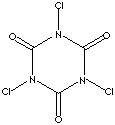| TRICHLOROISOCYANURIC ACID | ||
|
PRODUCT IDENTIFICATION |
||
| CAS NO. | 87-90-1 |
|
| EINECS NO. | 201-782-8 | |
| FORMULA | C3Cl3N3O3 | |
| MOL WT. | 232.41 | |
| H.S. CODE | 2933.69 | |
|
TOXICITY |
Orl rat LD50: 406 mg/kg | |
| SYNONYMS |
symclosene; Trichloroiminocyanuric acid; |
|
| 1,3,5-Trichloro-S-triazine-2,4,6-trione; 1,3,5-trichloro-1,3,5-triazine-2,4,6(1H,3H,5H)-trione; 1,3,5-Trichloroisocyanuric acid; 1,3,5-Trichloro-s-triazine-2,4,6(1H,3H,5H)-trione; Isocyanuric chloride; | ||
|
SMILES |
||
|
CLASSIFICATION |
|
|
|
PHYSICAL AND CHEMICAL PROPERTIES |
||
| PHYSICAL STATE |
crystalline substance |
|
| MELTING POINT | 246 - 247 (decomposes) | |
| BOILING POINT |
|
|
| SPECIFIC GRAVITY | ||
| SOLUBILITY IN WATER | 12 g/l | |
|
SOLVENT SOLUBILITY |
soluble in chlorinated and highly polar solvents |
|
| pH | 3.0 (1% sol.) | |
| VAPOR DENSITY | ||
| AUTOIGNITION |
|
|
| NFPA RATINGS | Health: 2 Flammability: 0 Reactivity: 2 | |
|
REFRACTIVE INDEX |
||
| FLASH POINT | 225 C | |
| STABILITY | Stable under ordinary conditions | |
|
DESCRIPTION AND APPLICATIONS |
||
| Triazine is the chemical species of six-membered heterocyclic ring compound with
three nitrogens replacing carbon-hydrogen units in the benzene ring structure.
The names of the three isomers indicate which of the carbon-hydrogen units on
the benzene ring position of the molecule have been replaced by nitrogens,
called 1,2,3-triazine, 1,2,4-triazine, and 1,3,5-triazine respectively.
Symmetrical 1,3,5-triazine is the common. Triazines are prepared from
2-azidocyclopropene through thermal rearrangement (1,2,3-triazine), from
1,2-dicarbonyl compound with amidrazone by condensation reaction
(1,2,4-triazine) and from cyanic acid amide by trimerization (1,3,5-triazine).
Pyridine is the aromatic nitrogen heterocycle compound having only one nitrogen,
and diazines are with 2 nitrogen atoms and tetrazines are with 4 nitrogen atoms
on the benzene ring system. Triazines are weak base. Triazines have much weaker
resonance energy than benzene, so nucleophilic substitution is preferred than
electrophilic substitution. Triazines are basic structure of herbicides,
examples are amitole (CAS #: 61-82-5), atrazine (CAS #: 1912-24-9), cyanazine
(CAS #: 21725-46-2), simazine (CAS #: 122-34-9), trietazine (CAS #: 1912-26-1).
Large volume of triazines are used in the manufacture of resin modifiers such
as melamine and benzoguanamine. Melamine (1,3,5-Triazine-2,4,6-triamine) is
reacted with formaldehyde to from a very durable thermoset resin. Benzoguanamine
(2,4-Diamino-6-phenyl-1,3,5-triazine) is used to increase thermoset properties
of alkyd, acrylic and formaldehyde resins. Triazines are also useful as
chromophore groups in colorants and Chlorine attached in Triazine compounds
undergo nucleophilic substitution reactions well with with hydroxyl groups in
cellulose fibres. Some triazine family compounds are used in pharmaceutical
industry as coupling agent for the synthesis of peptide in solid phase as well
as solution and as side chain of antibiotics. Triazine compounds are used in
formulating bactericide and fungicide. They are used as preservatives in oil
field applications. They are used as disinfectant, industrial deodorant and
biocide in water treatment. They are used as a bleaching agents.
Cyanic acid (also called fulminic acid) is an unstable (explosive), poisonous, volatile, clear liquid with the structure of H-O-C��N (the oxoacid formed from the pseudohalogen cyanide), which readily polymerizes to cyamelide and fulminic acid. Cyanuric acid (also called pyrolithic acid), white monoclinic crystal with the structure of [HOC(NCOH)2N], is the compound of polymerized (trimer) cyanic acid (a symmetrical triazine containing three carbon and three nitrogen atoms in a ring structure); white monoclinic crystals; slightly soluble in water. Cyanic acid hydrolyses to ammonia and carbon dioxide in water. Its salts and esters are cyanates (or called fulminates). Esters of normal cyanic acid are not known. There is another isomeric cyanic acid with the structure of H-N=C=O, which is called isocyanic acid. Its salts and esters are isocyanates. Another trimer of cyanic acid is called isocyanuric acid (also known as fulminuric acid); soluble in water; melting at 138 C, and exploding at 145 C. Cyanates (or Isocyanates), cyanurates (or Isocyanurates) are used in the manufacturing pharmaceuticals, pesticides, textile softener and lubricants They are used in industrial disinfectants through the conversion to polycyclic compounds (such as hydantoins and imidazolons). They are used as plastic additives and as heat treatment salt formulations for metals. Trichloroisocyanuric acid is used as a chlorinating agent, disinfectant, industrial deodorant and biocide in water treatment. |
||
| SALES SPECIFICATION | ||
|
APPEARANCE |
white crystalline powder or tablet (15gr - 200gr) |
|
| CHLORINE CONTENT |
90.0% min |
|
|
WATER |
1.0% max |
|
| pH |
ca 3 (1% sol.) |
|
| TRANSPORTATION | ||
| PACKING | 50kgs in plastic drum, 20mts in container | |
| HAZARD CLASS | 5.1 (Packing group: II) | |
| UN NO. | 2468 | |
| OTHER INFORMATION | ||
| Hazard Symbols: O XN N, Risk Phrases: 8-22-31-36/37-50/53, Safety Phrases: 8-26-41-60-61 | ||
| PRICE INFORMATION | ||
